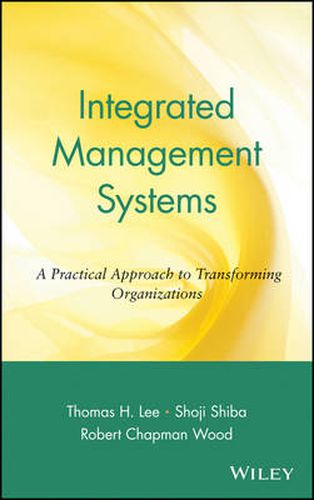Readings Newsletter
Become a Readings Member to make your shopping experience even easier.
Sign in or sign up for free!
You’re not far away from qualifying for FREE standard shipping within Australia
You’ve qualified for FREE standard shipping within Australia
The cart is loading…






Based on a profoundly important six-year study by the Center for the Quality of Management (CQM), Integrated Management Systems shows how successful organizations accomplish something unbelievably powerful: Creating their own particular ways of executing the scientific method. The authors worked with the cooperation of some of America’s largest companies - Teradyne, Hewlett-Packard, Eastman Chemical, Ritz-Carlton – and of non-profit organizations including top hospitals and the U.S. Navy. They were surprised to find how radically successful systems differed from one organization to the next. Yet the core of each was universal: Each organization had designed a system that gathered data about the organization’s particular problems, developed theories, tested the theories, and finally documented and shared the results throughout the organization. Each successful organization’s methods were unique much as the methods of each successful discipline within the sciences are unique. But less successful organizations had nothing comparable. And the processes through which the leaders in these organizations had gotten them on the right path had a great deal in common.
$9.00 standard shipping within Australia
FREE standard shipping within Australia for orders over $100.00
Express & International shipping calculated at checkout
Based on a profoundly important six-year study by the Center for the Quality of Management (CQM), Integrated Management Systems shows how successful organizations accomplish something unbelievably powerful: Creating their own particular ways of executing the scientific method. The authors worked with the cooperation of some of America’s largest companies - Teradyne, Hewlett-Packard, Eastman Chemical, Ritz-Carlton – and of non-profit organizations including top hospitals and the U.S. Navy. They were surprised to find how radically successful systems differed from one organization to the next. Yet the core of each was universal: Each organization had designed a system that gathered data about the organization’s particular problems, developed theories, tested the theories, and finally documented and shared the results throughout the organization. Each successful organization’s methods were unique much as the methods of each successful discipline within the sciences are unique. But less successful organizations had nothing comparable. And the processes through which the leaders in these organizations had gotten them on the right path had a great deal in common.